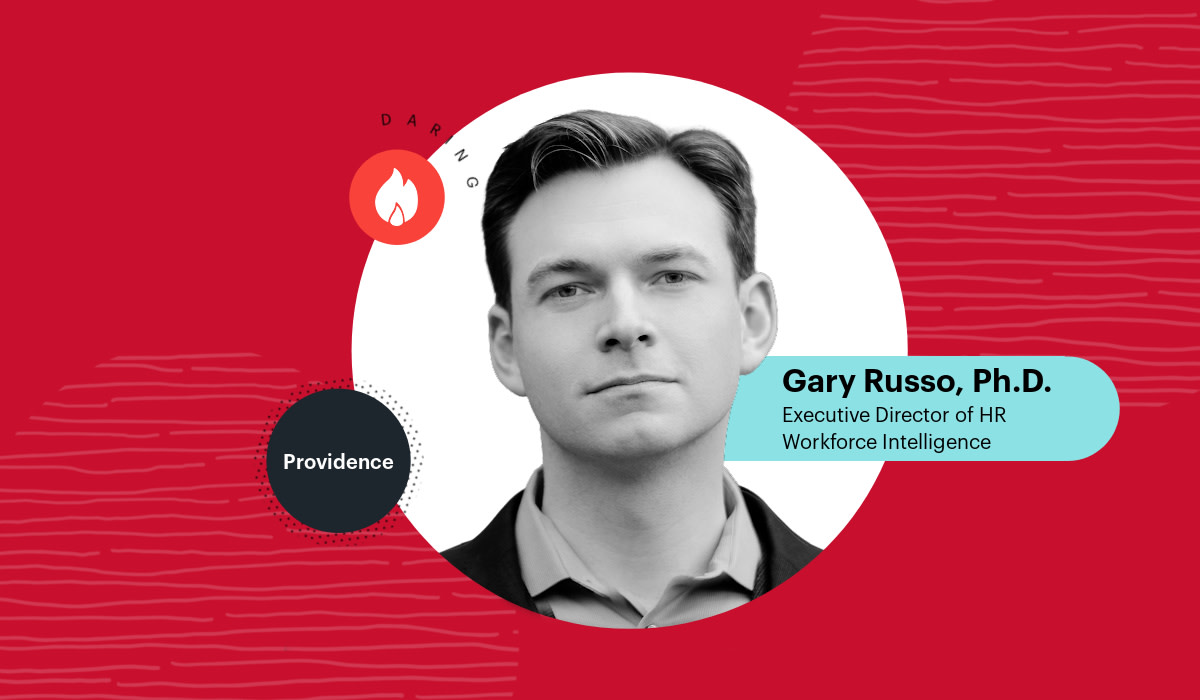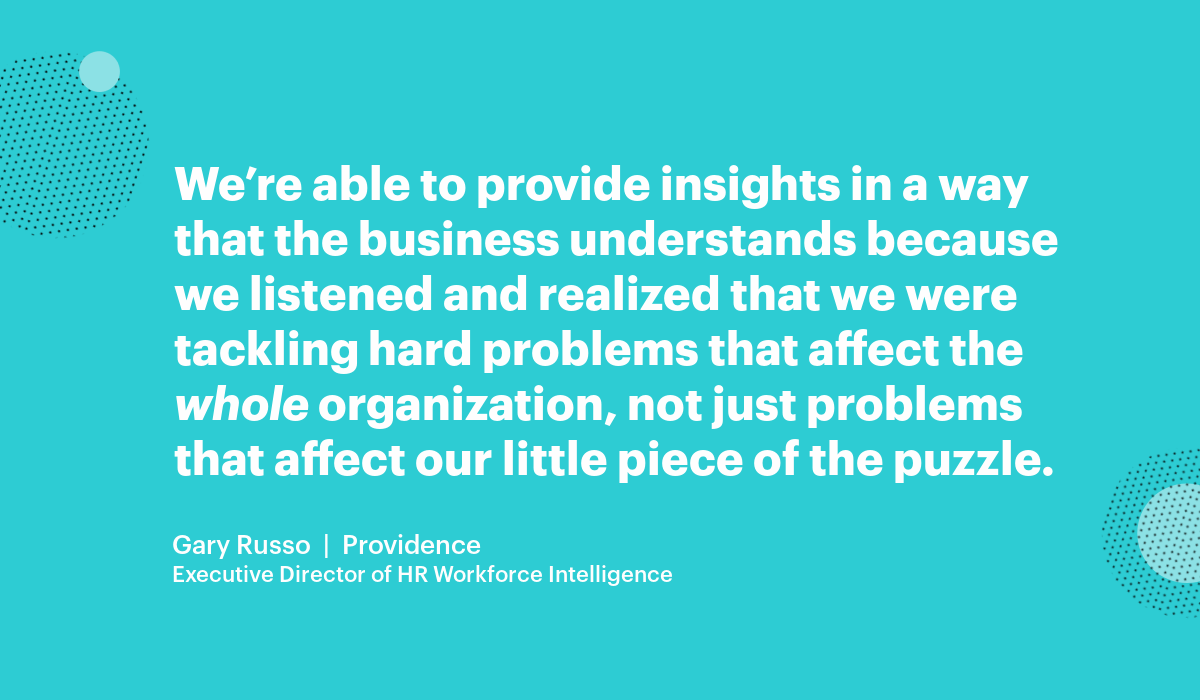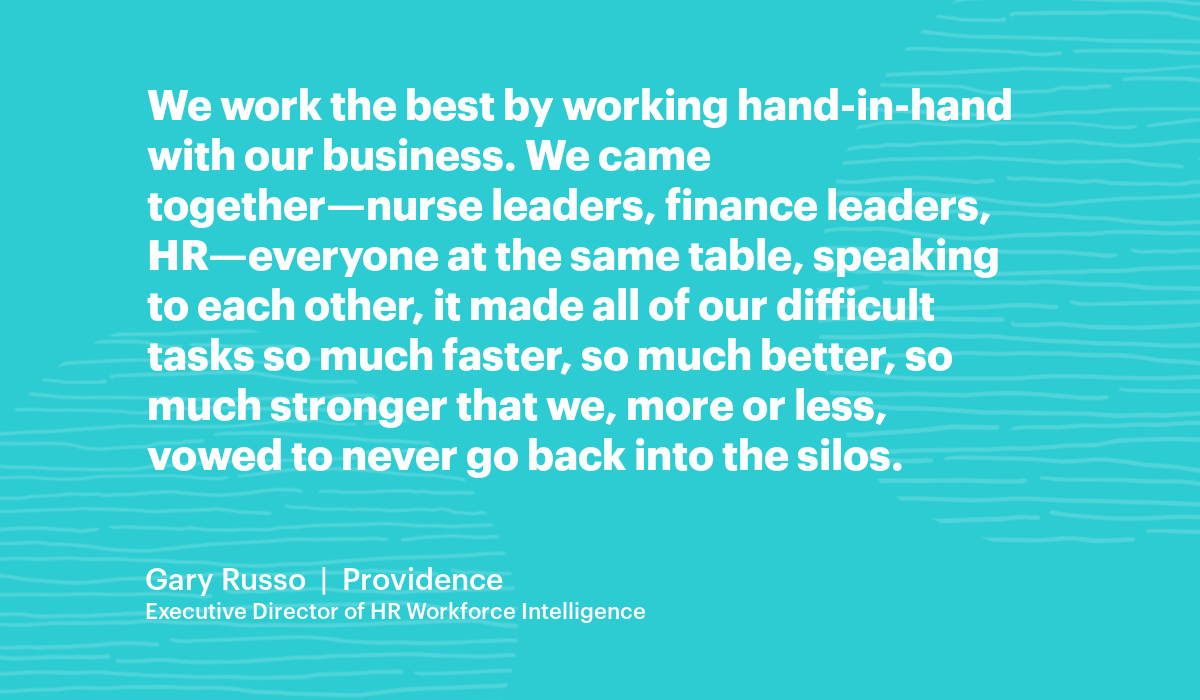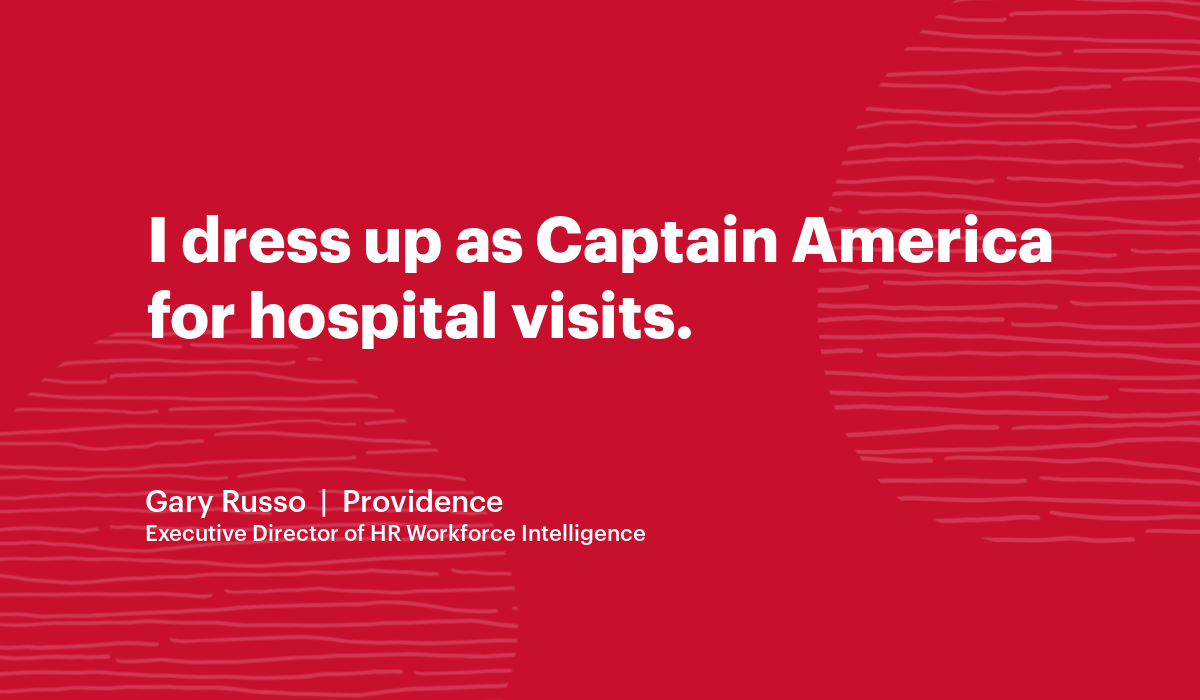The Many Layers of Providence’s Gary Russo, Workforce Intelligence Analyst and Ex-Superhero
In this profile, we talk to Providence's Gay Russo about his unique path to HR, supporting healthcare workers during COVID, and Captain America.

The last 18 months proved that strong HR leadership is needed more than ever. In this profile series, we celebrate the HR Super Leaders that led their organizations through tough times by harnessing their HR superpowers—daring, vision, empathy, strategy, and connection—and proving that anything is possible when you put your people first. Learn more about these five superpowers and take our quiz to find out which one is yours!
Gary Russo never planned to work in human resources or, for that matter, to lead a workforce intelligence team that supports 120,000 people at 50 hospitals in seven west-coast states. Instead, his original focus was in molecular and cellular biology, earning a doctorate in the field. Now, as the Executive Director of HR Workforce Intelligence at Providence, a “mission- and passion-driven healthcare system,” Gary says that his science training still applies. “When I researched in a neuroscience lab, I was trained how to approach questions that had never been answered,” he explains. “I understand what it means to seek as much information as possible while acknowledging that there is not always an answer at the end—it makes a lot of the questions I face today very approachable.”
Gary is, himself, very approachable and loves to talk about his work ”improving the lives of people who save lives.” Read on to learn how he pivoted amidst the onset of the global pandemic in order to dispatch medical staff where and when they were most needed (and how he dressed like a superhero pre-pandemic just to make kids happy).
Tell me about your role as Executive Director of HR Workforce Intelligence at Providence, what does a typical day look like for you, Gary?
It’s really about making sure that we’re balancing the stuff that’s happening today with making sure that our current actions are supporting our one, three, and five-year goals—both as a HR insights function, as well as an organization. And somewhere in all of that, trying to hire people.
How is your team situated within the organization?
Our team is workforce intelligence and I am excited that we are growing in the very near future, assuming we can find people to answer the call! We are situated under workforce strategy and analytics, a newer function for Providence. It’s a cross-functional team. We have leaders from nursing, finance, HR—which is myself—and operations. And all of us come at these big workforce problems from our different lenses. So, we tackle a wide variety of challenges together. Things like workforce insights and people analytics. We tackle labor optimization and productivity. How do we engage with our colleges and students to build our future pipelines. So, we’re acting as a strategic insights and optimization arm inside of HR.
You started your career with a Ph.D. in molecular and cellular biology. What led you to pursue a career in HR people analytics instead?
In academics, the path toward doing good for the benefit of people could take 10 or 20 years. You make a discovery. Maybe 20 years later, someone makes a pill and cites your work. At that point, you have truly helped someone. I had a chance to go into healthcare, and I fell in love with this ability to prove that you could hire more people—more nurses—that would take care of patients the same day, while also saving the organization money. The right thing to do was also the economic thing to do. And I just fell in love with being able to do that, and it kept me attached to the space.
You find this work rewarding, then?
I do. Improving the lives of people who save lives, that’s the goal.

And especially during the last year and a half. What was a business challenge that reared its head during this time that you and your team had to adjust to and try to overcome?
What do you do when you no longer have the workforce you need to take care of your patients? Basically, if COVID hit us full force, could we take care of the patients that came through our doors or not? Did we have enough people in hard-hit locations, or did we have to maybe go source them from other areas? Especially early in the pandemic, we had big pockets of COVID in one state, but nothing in another. And we were being tasked with finding ways to move caregivers around to meet these needs.
We were faced with: How do you pivot? And we wound up working with our business, getting very close with our nursing leaders, and understanding exactly what care needed to happen. We published a tool within about 72 hours that helped people understand the implications of a potential COVID surge, and then backed in our workforce needs. We were able to identify where those gaps were, and start target which people needed to move across geographies. We did wind up publishing a version of that tool through Visier’s blog, and when Visier was setting up their pandemic response community, it was well-received. But that was really our biggest challenge: everything we’d known was out the door. Our whole concept of how provide care was changing nationally, overnight. But we wanted to make sure we could take care of our patients, so we had to adapt.
What insights did you gain from doing all of that that you think you can use going forward into 2022?
We work the best by working hand-in-hand with our business. Not just our own workforce team, but HR in general—we came together, nurse leaders, finance leaders, HR, and we all sat down and tackled problems together. And just having everyone at the same table, speaking to each other, made all of our difficult tasks so much faster, so much better, so much stronger. We more or less vowed to never go back into the silos.
Even today, some of our nursing leaders are now perpetual attendees of our HR calls and vice-versa. They are a critical part of our discussion groups and decision making. We are able to provide insights in a way that the business understands because we’ve listened and realized that we were tackling hard problems that affect the whole organization, not just problems that affect our little piece of the puzzle.

That’s great. This sounds like an environment that can help with buy-in on doing the kind of work that you’re already doing quite a bit.
We’ve learned a lot from our peers. We have—HR and my team—been able to share deeper information around the people who do the work, and the types of jobs they do. But we’ve also been spring boarded ahead because we listen as much as we share. It turns out all the information and context we always struggled to find about our business in HR, like identifying all emergency services departments across 53 hospitals, is easily accessible through our Finance team. By partnering, we’ve jumped light years ahead, because now we understand how the business does its work, and we can integrate that to our systems. And then they understand more about the people doing the work, and can back that into their budgets and projections. So, we don’t have to reinvent the wheel anymore.
Understanding “the people doing the work,” is that how you put the human in human resources in your job?
I remember my first job in HR, there was a gentleman who was applying for a job in the front office and he was having some troubles. The admin stepped over and asked, “Can I help you?” And he said, “I would like help applying for a job.” She said, “Okay, well, click on the desktop icon and we’ll get you started.” He looked confused, and she rephrased to, “Put your mouse on the icon.” He lifted the mouse and put it against the screen, and looked at her expectantly like, “Okay, now what?”
This stuck with me because the reality is he would be a perfect fit for a job we needed. It didn’t matter that he didn’t know how to use a computer. That was our job: to make it easier for him to get past our hurdles. And when I think about putting the human in human resources, I try to imagine the folks who are just trying to get their job done, who are just trying to be successful and provide help. We should not assume a level of anything that’s not essential. How do we make it convenient for them? How do we make sure that if we’re asking them to do something that we make it easy. So that we’re taking away stress from them and not adding it.
That’s how I try to strike a fair balance: I just remember that it’s all on us. It’s our ethical responsibility to make it easy for them.
Did the guy get hired?
I believe he did! As one of our housekeepers- keeping our patient spaces clean.

Let’s talk about your HR Superpower. You got Daring. Why do you think this superpower is important in HR?
Our organization is 162 years old. Our history as a society, but also as a work culture, is not great. We know we’re moving toward better places over time, both from an equity standpoint and from a work-life balance standpoint. But our history betrays us more often than not. A lot of things people believe to be true are not supported by anything tangible. I think it’s incredibly important to be daring, because daring asks what is the right way of doing things, regardless of how things have been done before. Are we standing in our own way of getting to that right thing because we’re so attached to our past?
What do you think happens when HR professionals, or HR departments lack this daring superpower?
I think that HR does need to advocate for employees. There’s an imbalance in power between an employer who chooses to issue a paycheck or not, and the employee who will be on the street and not be able to take care of their family if they don’t get that paycheck. There’s always an imbalance in the relationship. HR is one of those protecting lines that make sure things operate in a way that everyone’s agreed to, if nothing else. If you are not daring in HR, if you are not pushing the envelope to validate that things are happening in a fair way, that does not help the employee who’s already at a disadvantage.
I think there’s always that need to be some level of daring. Whether it is reflecting on whether a manager is making the right choice, or whether it is assessing if our policies prevent us from being an equal opportunity organization.
Do you happen to have a favorite comic book superhero or superpower?
I dress up as Captain America for hospital visits. So, yes.
Wait, what?! Who do you visit when you dress up like Captain America?
Because of the pandemic I can’t do that anymore, but I had visited a couple of children’s wards in local hospitals. And then my wife and I started a little not-for-profit thing. We would visit toy stores, local parades, community events, and things like that. We’d hang out with the local police or fire fighters. They would bring out their trucks or tools and there’d be Captain America. There was always something special about the moment a kid, or sometimes the parents, looked up and saw their hero waving at them.
Meet the rest of our HR Super Leaders and find out your HR superpower.
Get Outsmart content straight to your inbox
Subscribe to the People Insights Monthly newsletter for actionable insights and stories.
Subscribe now